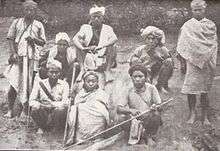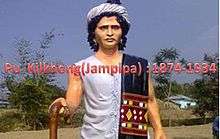Thadou people
Thadou people are an indigenous group inhabiting North-east India, Chin state in Burma and eastern Bangladesh. Thadou is a dialect of the Tibeto-Burman family. It is spoken in different parts of Manipur. It is the second largest dialect after Meeteilon (Meitei language). In Manipur, the Thadous are found in all the district. They are the second largest in terms of population in Manipur, next to Meetei according to Manipur census 2011. Thadous people lives in Mizoram, Nagaland, Assam, Tripura, Meghalaya, Bangladesh,Burma and different parts of the world including United States of America and the United Kingdom. Thadous share a common culture with all the Chin-Kuki-Mizo community.
Religion
A great majority of the Thadou people are Christians. Christianity among the Thadous can be traced back to an Anglican named William Pettigrew who worked in Manipur as a missionary from 1894. The 100th anniversary of the Thadou people embracing Christianity was held at Motbung, Sadar Hills, Manipur, India on 13 December 2008 under the aegis of the Thadou Baptist Association. Some 10% of the Thadou populace around the world are following Judaism as they are believed to be descendants of Manasseh, one of the 12 tribes of Israel. Some 5000 of Kuki people are now settled in Israel.
History
The Thadou people believed that Chongthu, a great Chief of the Thadous, emerged out from a cave called "Chhinlung or Shinlung or Khul" the location of which was believed to be somewhere in Central China, whereas others claimed it to be in Tibet. (Ginzatuang 1973:5) Mc. Culloch (1857:55). Those ancestors emerging from the cave include Chongthu/Songthu, Khupngam, Vangalpa and some clansmen, leaving behind Noimangpa, Chongja and others of the group.
William Shaw's (1929) description about the origin of Thadou is recorded from collected oral traditionals. According to the Thadou narrative recorded by Shaw (1929), Noimangpa was the chief of subterranean region. Chongthu, a relative of Noimangpa, while hunting in the jungle with his dog, discovered a large cave. Chongthu, rejoiced at this discovery, gave up his hunting and went back to his village. He conjured up ideas of forming his own village on the earth. Meanwhile, Noimangpa the chief of the underworld was performing the ‘chon’ festival, in which everyone including chongja, the elder brother of Chongthu, Noimangpa’s son Chonkim participated. During this feast Chongthu started waving his sword so vigorously that he injured some of the people present, at which all were annoyed. This action of Chongthu was premeditated so that he can find an excuse to go to the upper world to form a village of his own. When Noimangpa came to know this he wanted Chongthu dead. Chongthu on hearing Noimangpa’s wrath, prepared to leave for the uninhabited earth, ‘khul’, as spoken of by the Thadous. So, Chongja and Chongthu along with the cavemen feasted before their departure. On their journey to the upper crust of the earth there was a great darkness, which lasted for seven days and seven nights, called “Thimzin” by the Thadous. They found a stone blocking their passage out and after making many attempts Chongja and party gave up and returned to Noimangpa and reported the result’. Pi Nemneh, wife of Songja, cursed Chongthu and party for leaving them at doom in ‘Khul’. It is also believed that Chongja, Noimangpa and other clansmen who were left behind are assimilated with the Chinese and Japanese people.

The Anglo-Thadou war (1917–19)

The Anglo-Thadou War (1917–19) was one of the important uprisings against the British imperialism which went on par with the Indian National Movement for Freedom. This movement was known by different names. The Thadous called it "Thadou gaal". The Meiteis called it "Khongjai Laal"(Khongjai war). The Zous called it Zougal . However, in the official records of Manipur it was known as Kuki Rebellion 1917–1919. It commenced from 17 March 1917 and concluded on 20 May 1919.
As a mark of protest against the British and to stop further recruitment of the Thadous and its cognate tribes in the non-combatant force at the battlefront in France in the First World War as per the appeal received from the Secretary of State for India, London, in his telegram dated 28 January 1917, the Thadous in Manipur openly fought against the British in the month of December 1917. The Chief of Aisan, Chengjapao Doungel, who was the "Piba" or head of the Thadou tribe, sent orders to all the leading Thadou chiefs to resist the British with force, if necessary. A very important meeting was held at Jampi Village. The chiefs who attended the meeting were:
- Pu Khotinthang Sitlhou alias Kilkhong, Chief of Jampi
- Pu Khupkhotintong (Tintong) Haokip
- Pu Songchung Sitlhou, Chief of Sangnao
- Pu Lunkholal Sitlhou, Chief of Chongjang
- Pu Vumngul Kipgen, Chief of Tujang
- Pu Lhunjangul Kipgen, son of Vumngul Kipgen
- Pu Enjakhup Kholhou, Chief of Thenjang
- Pu Leothang Haokip, Chief of Goboh
- Pu Mangkho-on Haokip, Chief of Tingkai
- Pu Heljason Haokip, Chief of Loibol
- Pu Onpilen Haokip, Chief of Joupi
- Pu Onpilal Haokip, Chief of Santing
- Pu Jamkhokhup, Chief of Boljang
- Pu Nguljahen Haokip of Boljang
Khotinthang Sitlhou (Kilkhong), the Chief of Jampi killed one Mithun to entertain the chiefs and "Sajam" was distributed to all the chiefs. Thus, a powerful conspiracy of the Thadou chiefs was established. And the Singson chief cut off the tail of a mithun as a mark of declaration of war against the British government on behalf of his clan. In Manipur, the rebellion spread like wild-fire, particularly in the Kuki inhabited areas – Jampi, Dulen, Sangnao, Khauchangbung and Laijang in the west; Chasat and Maokot in the east; Mombi and Lonza in the south-east and Henglep and Loikhai/Ukha in the southwest.
After many months of aggressive fight between the tenacious Thadou warriors and the mighty British force the Kuki Rebellion finally came to an end on 20 May 1919, with the subjugation of the Thadous by the British Rulers. The colonial authorities recorded the war as 'Kuki Rebellion". however, the Thadou and its cognate tribes called it Thadou gal. Sir Nicholar Beatson Bell, the former Chief Commissioner of Assam, also said that the Anglo-Kuki Rebellion, 1917–19 was confined entirely to the Thadous.
To commemorate the centenary celebration of the Anglo-Thadou War 1917-19 the Anglo-Thadou War (1917-1919), a Centenary Celebration was held on 17 March 2017 at Taloulong Village, Kangpokpi district.
Modern history
Thadous[1] has been recognised as Scheduled Tribe in India since 1956. The followings covered under the Amended Vide Govt. of India Ministry of Law Notification Order No. S.R.O. 2477A, dated 29 October 1956, New Delhi, India.
Thadou subgroups (clans) are as follows.
- Guite
- Doungel
- Sitlhou
- Singsit
- Lhouvum
- Lhoujem
- Thomsong
- Singson
- Sitkil
- Chongthu
- Kipgen
- Haokip
- Chongloi
- Hangshing
- Touthang
- Lotjem
- Haolai
- Tuboi
- Misao
- Sa-um
- Khuolhou
- Mate
- Baite
- Lhungdim
- Ngailut
- Kiloung
- Insun
- Jongbe
- Lenthang
- Thangngeo
- Lhang'um
- Khongthang
- Lunkim
Marriage
There are four forms of marriages among the Thadou: chongmou, sahapsat, jol-lhah','kijam mang. The latter two, sahapsat, jol-lhah', are non-ceremonial betrothal forms akin to elopement. The first of these forms involves the following elements.
- The negotiation of a bride-price between the parents of the groom and the parents of the bride (however one must note that the concept of 'bride price' mentioned here is very different from the Hindu concept of the 'dowry system')
- The establishment of a date for the departure of the bride from her parents' house to that of her husband
- The sending (by the groom) of strong young men to bring the bride to her new home; ceremonial feasting and wrestling then followed
- The triumphant return of the groom's representatives with the bride
The 'sahapsat' marriage form contains only the marital negotiations between families. The "jol-lhah" marriage is resorted to in the case of a pregnancy resulting from premarital relationships. In this case, a bride-price is usually agreed upon before the cohabitation process, which begins immediately when the pregnancy is discovered. The "kijam mang" is a marital arrangement that results from the union of two parties Without the consent of the parents of either bride, groom, or both by eloping. The bride-price is settled at some point after the union takes place. Post-marital residence is patrilocal . Inheritance is exclusively through the male line, i.e., eldest son. Thadou women are the chief agents of socialisation among the Thadou society. Children are permitted a great degree of independence once they learn to walk. Little structured education is provided by the parents, thereby leaving the Thadou child to learn through experiential means.
Literature
Dr. G.C. Crozier along with his wife Mrs M.B. Crozier and Pu Ngulhao Thomsong worked in full co-operation to translate the Bible especially in Thadou after obtaining permission from the British and Foreign Bible Society. Pu Ngulhao earlier works included, 1: Pathen La- 1922, 2: Thukidong leh Kidonbut – 1924, 3: Pathen Thu – 1925, 4: John Sut Kipana Thupha- 1925, 5: Lung Phatvet- 1930, 6: Rome Mite Henga Paul Lekha Thot – 1933.
The first edition of "Lekha bul:Thadou Kuki first primer" was written by Pu Ngulhao Thomsong in 1927.
Pu Longkhobel Kilong (1922) and was another native scholar of this period.
References
- are the single largest tribe in Manipur as per population census 2011.
Other sources
- Shaw, William. 1929. Notes on the Thadou kuki.
- Shakespear, J. Part I, London, 1912, The Lushai Kuki Clans. Aizawl : Tribal Research Unit.
- Tribal Research Institute. 1994. The Tribes of Mizoram. (A Dissertation) Aizawl: Tribal Research Institute, Directorate of Art and Culture.
- The Socio-Economics Of Linguistic Identity A Case Study In The Lushai Hills. Satarupa Dattamajumdar, Ph.D.
- Lieut. R. Stewart in the Journal of the Asiatic Society of Bengal (1857). entitled "A slight notice of the Grammar of Thadou or New Kookie language."
